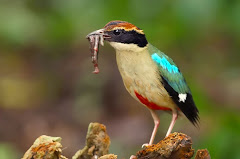An early name for Taiwan was the Butterfly Kingdom. Taiwan has a tremendously high density of butterfly species with around 400 butterfly species having been recorded on Taiwan (The continent of Europe and adjacent North African coast has around 440 species). The Huben-Hushan area, while famous for birds, is also home to many butterfly species. The butterflies and other insects of the area have been little studied and have hardly, if at all, been considered in the so-called environmental impact assessments (EIAs) done in the area for the Hushan Dam Project.
While forest and other habitat is fast disappearing due to the construction of Hushan Dam and other so-called development projects, naturalist Mark Wilkie and researchers from the Taiwan Endemic Species Research Institute have been recording butterfly species within the area over the past three years. Wilkie says that a butterfly list for the Huben-Hushan area listing around 140 species will be released shortly.
From late March through to about the tenth of April great numbers of Crow Butterflies (Euploea spp) pass through the Huben area on their spectacular journey from southern Taiwan to northern Taiwan. This butterfly migration is amongst the world's most spectacular butterfly migrations. Clearly, butterflies are another reason why the remaining forest within the Huben-Hushan area needs to be protected.
What follows are several photos of butterfly species recorded in the Huben-Hushan area. All photos are courtesy and copyright of Mark Wilkie.
Papilionidae:
Musk Swallowtail Byasa impediens febanus (80-90mm).
Paris Peacock Papilio paris nakaharai (80-90mm).
Common Rose Pachliopta aristolochiae interposita (70-90mm).
Tailed Green Jay Graphium agamemnon (60-80mm).
Common Bluebottle Graphium sarpedon connectens (50-60mm).
Golden Birdwing Troides aeacus formosanus (110-130mm).
Great Mormon Papilio memnon heronus (100-120mm).
Pieridae:
Common Albatross Appias albina semperi (50-60mm).
Grass Yellow Eurema hecabe (35-45mm).
Indian Cabbage White Pieris canidia (45-50mm).
Small Cabbage White Pieris rapae crucivora (45-50mm).
Wandering Snowflake Leptosia nina niobe (40-45mm).
Formosan Brimstone Gonepteryx amintha formosana (55-65mm).
Nympalidae:
Common Jester Symbrenthia lilaea formosanus (40-50mm).
Himalayan Jester Symbrenthia hypselis scatinia (35-43mm).
Asian Comma Polygonia c-aureum lunulata (48-58mm).
Indian Red Admiral Vanessa indica (50-60mm).
Blue Admiral Kaniska canace drilon (58-65mm).
Common Mapwing Cyrestis thyodamas formosana (45-50mm).
Orange Tiger Danaus genutia (70-80mm).
Glassy Tiger Parantica aglea maghaba (60-80mm).
Ceylon Blue Glassy Tiger Ideopsis similis (75-85mm).
Blue Tiger Tirumala limniace (80-90mm).
Blue-banded King Crow Euploea eunice hobsoni (80-90mm).
Striped Blue Crow Euploea mulciber barsine (75-95mm).
Double-branded Black Crow Euploea sylvester swinhoei (70-80mm).
Lemon Pansy Junonia lemonias aenaria (50-55mm).
Orange Oakleaf Kallima inachis formosana (70-80mm).
Formosan Ypthima Ypthima formosana (45-50mm).
Taiwan Wave-eye Ypthima multistriata (35-40mm).
Common Five-ring Ypthima baldus zodina (30-35mm).
Great Egg-fly Hypolimnas bolina kezia (65-100mm).
Common Sailor Neptis hylas lulculenta (47-55mm).
Rustic Cupha erymanthis (55-60mm).
Yellow Coster Acraea issoria formosana (60-75mm).
Common Palmfly Elymnias hypermnestra hainana (55-65mm).
Dark-brand Bush Brown Mycalesis mineus (45-50mm).
Bamboo Tree Brown Lethe europa pavida (55-65mm).
Lycaenidae:
Chinese Saphire heliophorus ila matsumurae (30-34mm).
Metallic Cerulean Jamides alecto dromicus (28-40mm).
Dark Cerulean Jamides bochus formosanus (26-30mm).
Pale Grass Blue Zizeeria maha okinawana (21-27mm).
Common Hedge Blue Acytolepsis puspa myla (24-32mm).
Malayan Megisba malaya sikkima (25-30mm).
Hesperiidae:
Restricted Demon Notocrypta curvifascia (40mm).
Formosan Swift Borbo cinnara (30-36mm).
Yellow Band Dart Potanthus pava (25-30mm).
Dark Palm Dart Telicota ohara formosanus (28-32mm).
Indian Palm Bob Suastus gremius (32-35mm).
Friday, November 21, 2008
Huben-Hushan Butterflies
Posted by
Wild at Heart Legal Defense Association
at
2:25 PM
![]()
Subscribe to:
Post Comments (Atom)






































































6 comments:
Lovely collection!
Thanks, Todd !
great collections of butterfly mark :)
Thanks, Horukuru !
What a fantastic collection. An incredible effort. Where do you find the common names? Are these Taiwanese translations?
Thanks, Steven,
Apart from the endemics, many of the butterflies found on Taiwan are found elsewhere in Asia. Species that are found in the former British colonies largely have English common names. Most common names can be found doing a Google search on the net but one needs to use credible sites. For books, butterfly field guides from Hong Kong, Malaysia, Singapore, India, and Australia help with many names. Some species are very widespread so even appear in the European guides. The best source for English common names is "Hong Kong Butterflies," Second Edition, 2005 by Philip Yik-fui Lo and Wing-leung Hui, ISBN: 988-201-631-6, [Hong-Kong] Agriculture, Fisheries and Conservation Department. It sells for HK$ 100. The Hong Kong Government Bookshop and many Hong Kong bookstores stock it. It can be ordered on-line. Butterflies of Hong Kong covers about 60% of the species found in Taiwan. Excluding the 70 odd Taiwan endemics the Hong Kong book covers around 80% of the non-endemic species so one is covered for all but the rarest of non-endemics. Several of the endemics do have English common names. One can always find the English common name for the genus so even those without an English species name can be placed in the genus as a "no common name Brown" etc. As we work on lists for TESRI the hope is that all involved can come to some kind of agreement on English common names for un-named species. Many the names are pretty straight forward as it would just be a case of adding Taiwan to the English genus name.
Post a Comment